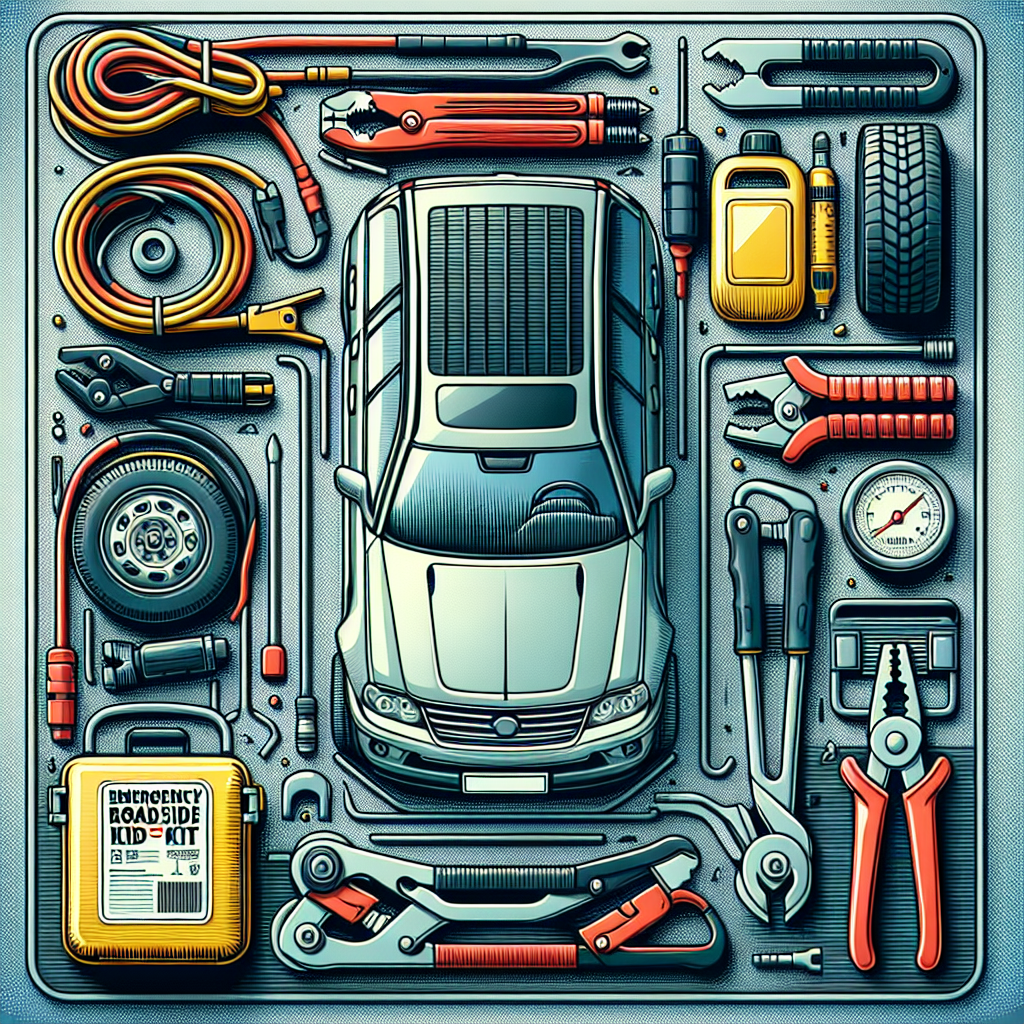
Emergency Roadside Kits: A Must-Have
Imagine you’re driving on a secluded road, enjoying the majesty of nature, when suddenly, your car breaks down. Panic sets in as you realize you’re stranded in the middle of nowhere with no help in sight. This is where having an emergency roadside kit becomes crucial. You never know when disaster may strike, and having the right tools and supplies at hand can potentially save you from a stressful, dangerous situation. In this article, we will explore the significance of emergency roadside kits and why they should be a staple in every driver’s trunk. From basic essentials to life-saving equipment, we’ll uncover the key items you should include in your kit to ensure you’re prepared for whatever unexpected mishaps the road throws your way.
What is an Emergency Roadside Kit?
Definition
An emergency roadside kit is a collection of essential items, tools, and supplies that every driver should have in their vehicle. It is designed to help you handle common roadside emergencies and ensure your safety until professional help arrives.
Purpose
The purpose of an emergency roadside kit is to provide you with the necessary tools and supplies to deal with unexpected situations while on the road. Whether it’s a flat tire, a dead battery, or a minor injury, having a well-stocked emergency kit can make a huge difference in how you handle these situations.
Essential Items
Jumper Cables
Jumper cables are crucial for jump-starting a dead battery. Having a reliable set of cables can save you from being stranded with a dead vehicle in the middle of nowhere. Make sure the cables are properly insulated and of sufficient length to reach between the vehicles.
Spare Tire
A spare tire is a must-have in case you experience a flat tire. Ensure that your spare tire is properly inflated, and check it regularly for signs of wear and tear. Also, make sure you have the necessary tools to change a tire, such as a tire jack and lug wrench.
Tire Jack
A tire jack is an essential tool for lifting your vehicle off the ground to remove and replace a tire. It is necessary for a safe and efficient tire change. Familiarize yourself with the proper use of the tire jack and have it easily accessible in your emergency kit.
Tire Pressure Gauge
Monitoring your tire pressure is important for maintaining optimal performance and safety. A tire pressure gauge allows you to check the air pressure in your tires regularly. Make sure to choose a gauge that is easy to read and compatible with your vehicle’s tire pressure specifications.
Tool Kit
A basic tool kit is invaluable in emergency situations. It can help you with minor repairs or adjustments until you can reach a professional mechanic. Include items such as pliers, screwdrivers, adjustable wrenches, and a socket set. A versatile and compact tool kit will prove to be a lifesaver in unforeseen roadside situations.
Emergency Tools
Flashlight
A reliable flashlight is essential for nighttime emergencies or when visibility is poor. Opt for a flashlight with long battery life or consider getting a rechargeable one. Keep spare batteries in your emergency kit to ensure its functionality when needed.
Reflective Warning Triangles
Reflective warning triangles serve as a visual warning to other drivers, especially at night or in low-light conditions. Place the triangles at a safe distance behind your vehicle to alert oncoming traffic of your presence. They play a crucial role in preventing accidents and keeping you safe.
Multi-purpose Knife
A multi-purpose knife can come in handy in various emergency situations. It can be used to cut seatbelts, open packages, or perform basic repairs. Choose a knife with a sturdy blade and additional features like a window breaker and a built-in seatbelt cutter.
Fire Extinguisher
A fire extinguisher is an essential safety item for any vehicle. It can help you put out small fires and prevent them from spreading. Make sure the fire extinguisher you choose is suitable for automotive use and easily accessible in case of an emergency.
First Aid Supplies
Bandages and Dressings
Having a variety of bandages and dressings is important for treating minor cuts, scrapes, or wounds. Include adhesive bandages, sterile gauze pads, adhesive tape, and antiseptic ointment in your first aid kit. Be sure to periodically check the expiration dates to ensure the effectiveness of the supplies.
Antiseptic Wipes
Antiseptic wipes are essential for cleaning wounds and preventing infection. They are convenient, easy to use, and a vital part of any first aid kit. Make sure to include a sufficient number of antiseptic wipes to address multiple injuries.
Gloves
Disposable gloves are necessary to protect yourself and others when providing first aid. They create a barrier between you and any bodily fluids that may be present. Choose gloves made of durable material like latex or nitrile and make sure they fit well.
Pain Relievers
Including pain relievers such as ibuprofen or acetaminophen in your kit can help alleviate minor aches and pains while on the road. Remember to follow the recommended dosage and consult a healthcare professional if you have any medical concerns.
Additional Safety Equipment
Safety Vest
A high-visibility safety vest is essential for ensuring your safety and signaling your presence to other drivers. It is especially important when dealing with roadside emergencies during low-light conditions. Invest in a quality safety vest that meets the necessary standards and keep it easily accessible in your vehicle.
Rain Poncho
A rain poncho can protect you from getting wet during unexpected rain showers while attending to a breakdown or changing a tire. Opt for a poncho that is lightweight, compact, and made of durable material. Always check your emergency kit before any road trip to ensure your rain poncho is in good condition.
Emergency Blanket
An emergency blanket, also known as a space blanket, can provide warmth and insulation in case you are stranded in cold weather. It is designed to retain body heat and can be a lifesaver in extreme conditions. Keep one or more emergency blankets in your kit, particularly during the winter months.
Whistle
A whistle is a simple yet effective tool for attracting attention and signaling for help. It can be used to alert nearby motorists or emergency responders if you are in distress. Attach a whistle to your keychain or keep it within easy reach in your emergency kit.
Important Documents
Insurance Information
Having your insurance information readily available is essential in case of an accident or emergency. Make sure to include copies of your insurance policy, contact information for your insurance company, and any necessary claim forms in your emergency kit.
Vehicle Registration
Your vehicle registration is another important document to keep in your emergency kit. It serves as proof of ownership and can be helpful in legal matters or when dealing with law enforcement. Ensure you have a current copy of your vehicle registration easily accessible.
Emergency Contact List
Having a written list of emergency contact numbers is crucial in case of an accident or an emergency situation. Include names, phone numbers, and any additional relevant information for family members, friends, and your roadside assistance provider. Update the list periodically to ensure the accuracy of the information.
Food and Water
Bottled Water
Staying hydrated is essential, especially during unexpected delays or emergencies. Keep a few bottles of water in your emergency kit to ensure you have a reliable source of hydration. Make sure to check and replace the water regularly to ensure freshness.
Non-perishable Snacks
Including non-perishable snacks in your emergency kit can provide sustenance during unexpected breakdowns or long waits for assistance. Choose snacks that are high in energy, such as granola bars, nuts, or dried fruit. Make sure to check the expiration dates and replace the snacks as needed.
Seasonal Considerations
Ice Scraper
During winter months or in cold climates, an ice scraper is essential for safely removing ice and frost from your vehicle’s windows and windshield. Clear visibility is crucial for safe driving, and an ice scraper can help prevent accidents caused by reduced visibility.
Salt or Sand
When dealing with icy or slippery road conditions, keeping a bag of salt or sand in your emergency kit can provide traction and improve tire grip. Sprinkle salt or sand around your stuck tires to help gain traction and get your vehicle moving.
Extra Warm Clothing
In colder climates or during winter travel, having extra warm clothing in your emergency kit can keep you comfortable and protect you from hypothermia. Include items such as gloves, hats, thick socks, and jackets that are suitable for cold weather conditions.
Sunscreen
During summer months or when driving in sunny areas, sunscreen is an essential item to protect your skin from harmful UV rays. Keep a small bottle of sunscreen in your emergency kit and remember to apply it regularly, especially if you are waiting outside for assistance.
Storage and Organization
Waterproof Bag or Box
To keep your emergency supplies protected from the elements, consider using a waterproof bag or box as part of your storage and organization system. This will ensure that your essential items remain dry and ready to use in any situation.
Compartmentalized Container
Using a compartmentalized container or storage organizer can help keep your emergency kit well-organized and easily accessible. Separating items into different compartments or sections will make it easier to locate specific items when you need them.
Inventory Checklist
Maintaining an inventory checklist of everything in your emergency kit is essential to ensure that you have all the necessary items and that nothing is missing or expired. Regularly review and update the checklist to keep your emergency kit up to date and fully stocked.
Conclusion
An emergency roadside kit is a vital resource that every driver should have. It provides peace of mind knowing that you are well-prepared to handle unexpected situations while on the road. By including essential items, emergency tools, first aid supplies, additional safety equipment, important documents, food and water, seasonal considerations, and organizing your kit effectively, you are equipped to handle various roadside emergencies and keep yourself safe. Remember to regularly check and replenish your emergency kit to ensure that it is always ready when you need it. Stay safe and prepared on the road with your comprehensive emergency roadside kit!









